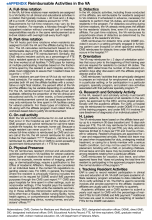Graduate Medical Education Financing in the US Department of Veterans Affairs
Background: The US Department of Veterans Affairs (VA) partners with 250 sponsors of graduate medical education (GME), annually providing $850 million for 11,000 full-time equivalent resident positions that support veteran patient care and provide educational opportunities for trainees from affiliated academic programs. Knowledge of VA GME financing is vital to maintain these partnerships.
Observations: In response to increased scrutiny from several federal oversight bodies, the VA revised its GME reimbursement policy and procedures, including implementing new resident tracking and auditing mechanisms. This article describes the VA GME reimbursement policies and procedures and, to facilitate understanding, compares GME financing policies of the VA and Centers for Medicare and Medicaid Services. Similarities include counting full-time equivalent positions for reimbursable resident activities (eg, patient care and didactics) and ensuring reimbursement is limited to 1 payment per resident. Differences include funding of resident salaries and benefits, indirect funding to support education, and the calculations to determine reimbursement.
Conclusions: The VA continues to refine its GME financing policies and procedures to maintain compliance with laws and regulations, and to provide accurate reimbursement to academic affiliates. This endeavor is essential to support the vital GME partnerships between the VA and its affiliate institutions.
Reimbursement
The VA provides reimbursement for clinical and educational activities performed in VA facilities for the benefit of veterans as well as research, didactics, meetings and conferences, annual and sick leave, and orientation. The VA also may provide reimbursement for educational activities that occur off VA grounds (eg, the VA proportional share of a residency program’s didactic sessions). The VA does not reimburse for affiliate clinical duties or administrative costs, although a national policy allows VA facilities to reimburse affiliates for some GME overhead costs.29
CMS similarly reimburses for residency training time spent in patient care activities as well as orientation activities, didactics, leave, and, in some cases, research.4,30,31 CMS makes payments to hospitals, which may include sponsoring institutions and Medicare-eligible participating training sites.4,30,31 For both the VA and CMS, residents may not be counted twice for reimbursement by 2 federal agencies; in other words, a resident may not count for > 1 FTE.4,30-32
GME Oversight
VA GME funding came under significant scrutiny. At a 2016 House Veterans Affairs Committee hearing, Representative Phil Roe, MD (R-Tennessee), noted that no process existed at many VA facilities for “determining trainee presence” and that many VA medical centers had “difficulty tracking resident rotations”16 A VA Office of the Inspector General investigation recommended that the VA implement policies and procedures to improve oversight to “ensure residents are fully participating in educational activities” and that the VA is “paying the correct amount” to the affiliate.17 A 2020 General Accountability Office report outlined unclear policy guidance, incomplete tracking of resident activities, and improper fiscal processes for reimbursement and reconciliation of affiliate invoices.18
In response, the OAA created an oversight and compliance unit, revised VHA Directive 1400.05 (the policy for disbursement), and improved resident tracking procedures.26 The standard operating procedure that accompanied VHA Directive 1400.05 provides detailed information for the DEO and VA facility staff for tracking resident clinical and educational activities. FTE counts are essential to both VA and CMS for accurate reimbursement. The eAppendix and the Table provide a guide to reimbursable activities in the VA for the calculation of reimbursement, with a comparison to CMS.33,34 The OAA in cooperation with other VA staff and officers periodically conducts audits to assess compliance with disbursement policy and affiliate reimbursement accuracy.
In the VA, resident activities are captured on the VA Educational Activity Record, a standardized spreadsheet to track activities and calculate reimbursement. Each VA facility hosting resident physicians manually records resident activity by the half-day. This process is labor intensive, involving both VA and affiliate staff to accurately reconcile payments. To address the workload demands, the OAA is developing an online tool that will automate aspects of the tracking process. Also, to ensure adequate staffing, the OAA is in the process of implementing an office optimization project, providing standardized position descriptions, an organizational chart, and staffing levels for DEO offices in VA facilities.







